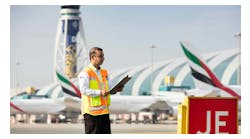Artificial intelligence (AI) is making a significant impact on the airport passenger experience, offering enhanced safety and security, smoother operations, and more personalized services.
Sharp Director of Solutions Marketing Commercialization Kelly Harlin explains how AI is transforming airports in various ways, leading to a better overall experience for passengers.
Enhancing Passenger Flow Management
AI helps airports understand passenger traffic flow by monitoring how many people are entering and exiting different areas, where they are spending time, and what times of day see the most activity.
According to Harlin, "Airports didn't have that information and they realized without understanding it, it was going to be really hard to start understanding the customer journey and their environment."
Harlin said when working with airport clients, there are many aspects of traffic and customer flow to consider. She emphasizes the importance of understanding foundational elements before pursuing ambitious plans to enhance the customer journey from entry to exit.
"We ask questions like, do you know how many people are coming in and out of your entrances and exits each day? Often, the answer is no. It's about starting with that baseline: how many people are coming in and out, which areas they are frequenting, and how long they are spending in different parts of the airport," Harlin explains.
This foundational data has provided valuable insights for airports, revealing the need to comprehend who is entering and exiting, at what times, and where they are spending their time in order to truly grasp the customer journey and optimize their environment.
Utilizing Existing Infrastructure
Deploying AI in an airport environment can be done without completely overhauling the existing infrastructure, as Harlin explains, "Airports have a lot of cameras, making them an ideal setting for AI usage.”
By leveraging existing cameras and understanding the angles at which customers move in and out, airports can begin to model and observe what happens in their space. Harlin notes that using these insights within their databases and visualizing the data helps simplify the process and keeps it practical.
"We focus on making use of existing infrastructure, which has proven extremely helpful for airports," she adds.
Improving Baggage Handling
Harlin said one of the major pain points in airports is managing the flow of bags, which can lead to friction, slowdowns, and bottlenecks. AI can help improve the baggage process at airports by visualizing and tracking the flow of bags.
"We're providing information to help customers make informed decisions about their bags, which improves efficiency and reduces operational issues," she adds. By syncing this information with the companies that handle baggage, airports can better understand the flow of bags from check-in to collection.”
AI can also detect and visualize the size of a passenger's luggage.
“When a customer comes walking up into the area, we can detect using our algorithm the size of that bag and visualize on the screen if that bag should be checked in or if it can go in the overhead,” Harlin said.
Virtual Queuing, Security and Streamlining Gate Operations
AI can provide valuable insights into how planes approach and dock at gates, the duration of jet bridge deployment, the efficiency of baggage offloading, and adherence to safety protocols.
Harlin points out, "AI, machine learning, and data collection can offer insights that the human eye might miss, allowing us to monitor security and operational activities in ways previously impossible without AI."
For instance, AI can detect unattended bags in restricted areas, unauthorized individuals entering secure zones, and track whether personnel are appropriately positioned on the tarmac.
"AI can send alerts to the control room, allowing for the deployment of security if someone enters a secure area or if unattended bags are present," Harlin said.
By enhancing security, customer experience, and operational efficiency, AI can significantly improve overall transportation operations in airports.
Harlin adds, "You can't get all that information and understand all the things that are happening in the environment without AI."
Data Collection
Airports can leverage AI to gain insights into passenger preferences and behaviors based on what passengers carry, wear, and drive. This information helps airports and advertisers tailor content to specific audiences.
Harlin explains, "They can actually advertise to them as they come into the airport based on the knowledge of the types of cars they're driving, for example." This creates opportunities for targeted marketing campaigns and additional revenue.
Airports collect vast amounts of data from various sources. AI helps analyze this data to inform decision-making and improve airport services.
According to Harlin, "Airports have a tremendous amount of data, and breaking it down into use cases and pain points allows them to apply that data to solve problems."
A Bright Future for AI in Airports
Looking ahead, Harlin believes that AI has the potential to revolutionize the airport experience even further by providing more personalized services, improving safety and security, and optimizing operational efficiency.
"The future for airports is building better spaces and building better customer experiences that are more secure," she says.
AI's ability to transform airport operations and the passenger experience is becoming increasingly evident. By focusing on specific use cases and leveraging existing infrastructure, airports can effectively deploy AI to achieve significant improvements in passenger satisfaction and operational efficiency.






